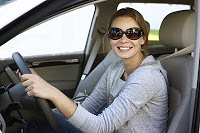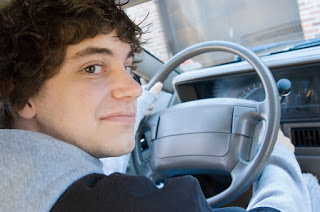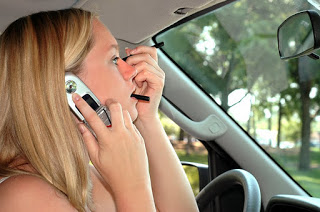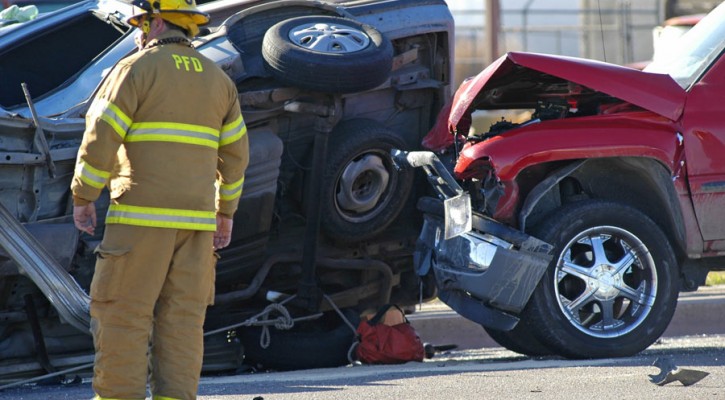Tag Archive: teen car accidents

Distracted Driving Campaigns
July 9, 2010
Buzz, buzz…it will just take a second to check. Ring, ring…it could be important. Yeah, I should go ahead and make that call. It will save me the time and hassle later on. The temptation to reach out and/or respond to some one through a cell phone is great. You have heard the news stories and safe driving campaigns and you know that you shouldn’t, but…do you resist the urge to use the cell phone or let temptation get the best of you?
In order to completely eliminate the urge to use your phone you could turn it off before turning your key in the ignition, lock it up (in the glove box, console, or trunk), or install some of the new technology for cell phones. There are several companies offering services that will restrict the phone’s ability to send and receive text and email messages. Some companies offer services that will restrict calls too. A sampling include:
Textecution – http://www.textecution.com
Textecution is an application designed for parents to install on their children’s phones. It utilizes the GPS features of several handsets to determine if the owner of the phone is moving at more than 10mph. It disables the texting function of the phone. If the person with Textecution on their phone is riding a vehicle as a passenger, or in a bus or train need to use the text feature, there is an “override” option — requesting for text access from the administrator. The parent who installed the phone is designated as the administrator, and can allow, temporarily for the phone to allow texting features. www.safefloridadriver.com
iZUP – http://www.getizup.com/
iZUP disables your phone entirely, removing any distraction from the road. It automatically forwards calls to voicemail and holds text messages while the phone is in motion. It is also time-delayed, to prevent reactivation of the phone’s features in natural stopping areas, like stop lights. The phone will only allow the user to make calls to 911 and 3 pre-approved numbers.
TXTBlocker – http://www.txtblocker.com/
TXTBlocker utilizes GPS locations to detect if the phone is traveling at a car’s moving rate and disables features of the phone accordingly. The installer of the TXTBlocker phone can also designate which areas are no-phone zones, and deactivates texting, calling, email and browsing. There’s also a feature that auto sends a text message to the parent, should the phone be moving at speeds greater than 65mph. Another safety feature for parents is they could check where the owner of the phone is in, based on GPS location. The phone will still be able to dial 911, in case of emergency. It only checks in with GPS every few minutes, so it doesn’t constantly use the phone’s battery.
DriveSafe.ly – http://www.drivesafe.ly/
DriveSafe.ly is a hands-free application that reads out text messages and emails as the phone receives it. There is an optional auto-responder that sends out a customized text message while the application is active.
Committing to be distraction free when you are driving is not easy. But the statistics remind us each day that we are more likely to have a collision when we are distracted, many drivers are making an effort. Regardless of whether it is hand held or hands free, the cell phone is a distraction for every driver.
Learn more about the Measures Taken to Stop Distracted Driving.

Motor Vehicle Crashes More Frequent For Teens with Own Cars
November 23, 2009
The journal Pediatrics recently published a study that showed that teens who report having their own vehicles (vehicles they don’t share with other family members) are more than twice as likely to have been involved in a recent motor vehicle crash. The study, a survey of 2,167 teens by researchers at Children’s Hospital of Philadelphia, indicated that teens who have their own vehicles are also much more likely to participate in other risky driving behaviors, such as using a cell phone and speeding.
Why might this be? According to driver safety experts, the following aspects of teens having vehicles for their sole use are potential contributors to the higher motor vehicle collision rate:
- The teen is more likely to have selected their own vehicle: Meaning a small, sporty car; high-powered, easily maneuverable vehicles tempt teens to drive faster and take more chances behind the wheel, such as weaving in and out of traffic.
- More driving time: When teens share a vehicle with other family members, they simply aren’t on the road as much. Teens who must return the vehicle by a certain hour so another family member can use it have a natural curfew that limits time on the road. While more driving time might make a teen driver more comfortable behind the wheel, she or he is not necessarily more skilled at driving. A false sense of confidence can lead teen drivers to take risks on the road.
- Extra freedom: When teens don’t have to request the keys, they quickly fall into the habit of driving whenever and wherever they want, and parents just as quickly get used to the freedom of not having to give rides to boisterous teens and their friends. This means that teens take more frequent trips, in addition to staying out longer.
- More passengers: Teens who don’t have to share their vehicles with their parents gain status amongst their friends because they can offer transportation to those who don’t have access to family vehicles. More time in the vehicle with teen passengers means trouble – teen passengers make driving much more risky for teen drivers.
Statistically, it’s safer for your teen to share a family vehicle rather than having one of their own. For parents who still intend to buy their teens their own vehicles, traffic safety professionals offer the following guidelines:
- Choose the vehicle carefully; research your options thoroughly. Teen drivers need stable, midsize vehicles with all the safety features you can afford. Frankly, if your teen is happy with your selection, it’s a sign that you may need to reevaluate your options and choose a different vehicle.
- Make sure your teen adheres to the Graduated Driver Licensing (GDL) laws in your state. If your state doesn’t impose time limitations for teen drivers, create your own as part of your house rules. Match the number of hours your teen is allowed to drive to the level of responsibility and maturity she or he exhibits.
- Don’t allow your teen to equate having her or his own vehicle to having unrestricted driving time. Set limits on the frequency and purpose for driving trips. Accompany your teen on trips in their vehicle occasionally and observe their driving behavior carefully, watching for any bad driving habits they may have picked up while driving alone.
- Use GDL laws and the number of safety belts in your car to determine the maximum number of passengers your teen is allowed to have in the vehicle.
Check frequently to make sure your teen is complying with your restrictions. Review your cell phone bill to ensure that your teen is not making calls when she or he is typically behind the wheel. Any deviation from the rules should result in restricted (or removed) driving privileges for a specified period of time. If teens aren’t following the ground rules for use of the vehicle, parents need to penalize them by taking the keys away and acting as chauffeurs for a time.

Teens and Motor Vehicle Crashes
August 28, 2009
The tragedy occurred on the last day before summer vacation. An SUV transporting a group of teens to the beach rolled over after a tire blowout. In the aftermath, four teens died, four were hospitalized, and the teen driver faced criminal charges.
Almost everyone knows a distressing story like this one; deaths of teens due to motor vehicle crashes are often well-publicized amid great community sympathy for the loss of young lives and the potential they held, as well as the devastation of surviving parents and friends. And they speak to a larger statistical reality – that motor vehicle crashes are the leading cause of death for 15- to 20-year-olds, according to the National Center for Health Statistics – that much of America seems to be both aware of, but unsure of how to change.
Consider the following statistics from the National Highway Traffic Safety Administration (NHTSA):
- There were 202.8 million licensed drivers in the United States in 2006 (2007 data not available). Young drivers between 15 and 20 years old accounted for 6.4 percent (13.0 million) of the total, a 7.2-percent increase from the 12.1 million young drivers in 1996.
- In 2007, 13 percent (6,982) of all drivers involved in fatal crashes (55,681) were young drivers age 15 to 20 years old, and 15 percent (1,631,000) of all drivers involved in police-reported crashes (10,524,000) were young drivers.
- In 2007, 3,174 15- to 20-year-old drivers were killed and an additional 252,000 were injured in motor vehicle crashes.
- Among 15- to 20-year-old drivers involved in fatal crashes in 2007, 31 percent of the drivers who were killed had been drinking.
- In 2007, 64 percent of the young drivers of passenger vehicles involved in fatal crashes who had been drinking were unrestrained. Of the young drivers who had been drinking and were killed in crashes, 75 percent were unrestrained. -During 2007, 35 percent of the motorcycle riders between 15 and 20 years old who were fatally injured in crashes were not wearing helmets.
In addition to mistakes made while driving, teens are susceptible to other lapses in judgment concerning motor vehicles that can lead to injury or death, such as car surfing. According to Science Daily, the states with the highest car-surfing fatality rates are California, Florida, and Texas; all three states have shown an increase in car-surfing deaths since 2000.
Though these three states show high levels of risky teen behavior concerning motor vehicles, a study conducted by Allstate Insurance Company indicated that rural areas have much higher rates of fatal motor vehicle crashes involving teen drivers than metropolitan areas; consequently, states with large rural areas have the highest rates of fatal crashes involving teen drivers. These states are:
- Mississippi
- Alabama
- Kentucky
- Missouri
- Arkansas
Nationally, Allstate’s research showed, fatal crash rates for teens were more than twice as high in rural areas than in metropolitan areas.
While considerable attention is paid to the issue of drunk driving among teens, law enforcement agencies report that speeding is the leading cause of motor vehicle crashes involving teen drivers. Allstate’s study found that law enforcement identified speeding as a factor in 34% of motor crashes nationwide, while alcohol was cited in just 12% of crashes.
In addition to the risk teens take when driving or when riding in a vehicle with other teens, teens suffer when a member of their peer group dies in a motor vehicle crash, particularly when they suffer multiple losses from crashes such as the example at the beginning of this article. Because of the feeling of invincibility that is characteristic of this age group, teens typically have not considered the deaths of people their age a possibility, so when such a thing occurs, their world may seem to be crashing down around them. This means that even teens who were not particularly close to the person who died can be stunned by their reaction to it. Due to their level of psychological maturity, teens are ill-equipped to understand the grieving process and may be overwhelmed by feelings of being out-of-control, insecure, and scared, in addition to sorrow and grief. They may descend into melancholy that lasts years, greatly affecting their development. Some teens numb their feelings by participating in high-risk activities such as:
- Alcohol and drug abuse
- Reckless sexual activity
- Withdrawal from family and friends
- Taking risks involving motor vehicles
Depending on the loss, some teens experience a change in their circle of friends. Obviously, this can have positive or negative results, but regardless, it is another change in a rapidly changing world for the teen. Teens who lose friends to death may see their grades drop and their focus change as they struggle to fit into a new group of friends at a time when they feel especially vulnerable.
Parents and other authority figures can help teens channel their grief in healthier ways by:
- Being available to listen – not, necessarily, to talk
- Allowing teens the freedom to process their grief with others, such as friends, extended family, and professional counselors
- Encouraging teens to express themselves through writing, drawing, and memorializing their deceased friends
- Realizing that the teens’ mourning process may be prolonged and letting teens know that there is no timetable for grief
Though the federal government, state governments, and community-based organizations are making efforts to reduce the number of teens who die in motor vehicle crashes, the statistics above indicate that there is still much work to be done. Forty-six states and the District of Columbia have three-stage Graduated Driver Licensing (GDL) programs in which restricted licenses are issued to beginning teen drivers, with the restrictions reduced over time. However, no state has incorporated all of the GDL components recommended by the Insurance Institute for Highway Safety, the National Transportation Safety Board, and NHTSA.
State-level programs that include peer-to-peer teaching and learning about driver safety are effective in reducing teen motor vehicle crash rates. Texas’ Teens in the Driver Seat is one such program; teen crash deaths have dropped 32% and the number of teen drivers involved in fatal motor vehicle crashes is down 33% since the program began. A similar program in Illinois called Operation Teen Safe Driving has helped achieve a 10% reduction in teen motor vehicle fatalities in Illinois during the first seven months of 2009. Mothers Against Drunk Driving (MADD), Students Against Destructive Decisions (SADD) and other advocacy groups sponsor many public education campaigns to persuade teens not to drive under the influence of alcohol or drugs.

Teens and Distracted Driving
May 14, 2009
Car crashes are the number one killer of American teens, and the primary cause of fatal teen crashes is driver error. Driver distraction is included in the broad category of driver error. Though not every distracted teen driver is involved in a crash, distraction increases the risk of either causing a collision or being unable to avoid one. And though distracted driving is a problem for any driver, it is of special concern for inexperienced drivers, who may be distracted more easily and for longer periods of time and who may have difficulty controlling the vehicle even under normal conditions.
Modern diversions such as cell phones and other technical equipment are simply additions to traditional distractions such as eating, reading, dealing with passengers, reaching for objects, and looking at things or people outside of the vehicle. Dealing with passengers is one of the most frequently reported causes of distracted driving, and lively teen passengers can be particularly distracting to new drivers. Distracted driving is nothing new, but educational efforts to combat it are increasing.
It’s important to realize that when you’re driving, you’re already multitasking, because you are:
- Trying to control a large machine at high speed.
- Responding to the driving environment, including road and weather conditions, other traffic, and road signs and signals.
- Reacting to changing conditions, such as other drivers pulling out in front of you and pedestrians crossing the road ahead.
Adding another task to this list might be just enough to make you lose control of your vehicle or fail to act in time to prevent a collision.
The following tips will help prevent distracted driving:
- Increase your awareness of both physical and mental distractions. Physical distractions occur when you take your hands off the wheel and/or your eyes off the road. They happen when you adjust your stereo, take a drink of water, or reach for an object that has fallen on the floor. Mental distractions are sometimes more difficult to identify, because they don’t necessarily interfere with the physical act of driving. They occur when you argue or even laugh with a passenger, receive surprising or interesting news on your cell phone, or are preoccupied with a problem at school or work.
- Minimize the need for adjusting controls while you are driving. Take a few moments to prepare for your trip when you enter the vehicle. Adjust the seat position, climate control, stereo, and other devices before you leave your driveway or parking spot. If you are driving an unfamiliar vehicle, spend a few extra seconds locating the controls so you won’t need to look for them while you are driving.
- Review driving directions and maps, enter your destination into your navigation system and check traffic conditions before you leave. If you have a passenger, she or he can act as your navigator. Avoid sudden stop and turns while on the road by pulling over in a safe place, off the road and away from traffic, if you get confused or lost.
- Pull over to a safe place, off the road and away from traffic, to talk on the phone, text message or email. Using hands-free equipment is not safe enough because of the likelihood of mental distraction. Turn the phone off before you start out to reduce temptation.
- Stop at restaurants to eat or drink. Unwrapping food and condiment packages, reaching into bags, and having greasy fingertips are physical distractions. Realizing that you got the wrong sandwich is a mental distraction that is difficult to correct once you’ve left a drive-through window. Spilling coffee on your new shirt qualifies as both a physical and a mental distraction. Reduce your risk of a crash and your stress level by taking a few minutes to enjoy your meal outside of your vehicle.
- Keep in mind that your vehicle’s mirrors exist to help you view traffic, not yourself. Don’t use them for personal grooming while the vehicle is in motion.
As a driver, your only task when you enter your vehicle is to arrive safely at your destination. Anything else can be taken care of when you arrive. As a new driver, begin developing good habits right away by avoiding distractions and concentrating on your driving.

Preventing Teen Vehicular Crashes
October 10, 2007
Geico, the automobile insurance giant, is not just known for their cute gecko or grunting cavemen commercial shtick. They also produce some great informational tools about your insurance and safe driving tips. There is an informational sheet Geico produced about the Top Ten Tips for preventing teenage crashes.
Really, the information is nothing new to anyone but it pays to be repetitive right? Teens probably only really absorb a quarter of what they hear and read when it is not a subject matter they really want to hear about like cleaning their room or *gasp* how to drive responsibly. Perhaps some parents should use the tip handout and tell their teens there will be a pop quiz on it later! Maybe then they will actually read it.
Anyway… there are some tips on there that are not really emphasized on other responsible teen driving diatribes. For instance, one of the tips is keeping it slow and steady and gradually build up to speedier driving venues. What this means is do not start driving lessons with your teen on the major highways that mimic the infamous Autobahn. Instead ease their way into those roads by practicing on driving within small towns or country roads. Practicing those speedy highways during down times is also beneficial. As the teen (and you as the parent) feel more confident about venturing on the highways in the height of craziness, then you can do so.
Another tip that doesn’t get as much play in the teen driving world is training to drive in poor conditions. Many parents are more apt to keep their teens from driving in the rain, snow or other weather conditions. This means, of course, that your teen will have no experience whatsoever in them. The best thing you can do (even though you won’t want to) is to take them out driving, at least in low populated or slow areas, during these conditions. If anything, drive around in the inclement weather in large parking lots, practicing turns and such for the experience. There are less things to hit in an empty parking lot!
Driving a safe vehicle is another safe teen driving tip and one that many people take for granted. Usually, the teen car is either the family car or a hand-me-down. On occasion, a new car or a used model may be purchased. Whatever you choose for your teen to tool around in, you must be sure that it is safe to drive. In this safe teen driving tip, you are the one that holds the ultimate power.
